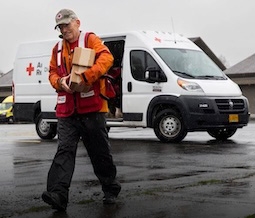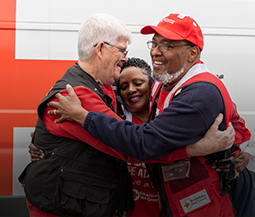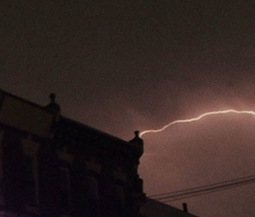From the winding mountain road, silver flashes in the sharp winter sun. It is reflecting off the new corrugated iron that roofs almost every building in this part of Nuwakot district, five hours’ drive from Nepal’s capital, Kathmandu.
One of these houses belongs to Januka Tamang. After losing everything in the April 2015 earthquake, she now shares a corrugated iron shed with her daughter, 6, and son, 12. Her husband—like many men here—works overseas to support his family. She last saw him 18 months ago.
As winter bites in mountainous Nepal, Januka Tamang and families like hers will need extra help to stay warm. That’s why the American Red Cross—in coordination with the government of Nepal and the Nepal Red Cross—is distributing 10,000 Nepali rupees (94 US dollars) cash each to 10,000 households before the end of 2015.
On a bright winter’s day, Januka Tamang collects her money from a Red Cross distribution point in Lachyang village. The money comes with no conditions, but the Red Cross has suggestions for what to buy to stay warm during the winter: clothing, blankets and mattresses.
Januka’s wishes are even more basic.
“There are no doors on my shed so I’m planning to buy plywood to make doors. I’m worried about burglary. We also have to sleep on the floor so I’m worried about the cold this winter. My next priority is blankets.”
At 1,400 meters high, Lachyang is below the 2,000 meter snow line, but it will get very cold, especially for people living in temporary shelters. The village is located in Nuwakot district, where 90 percent of houses were badly damaged by the spring quake.
“Before the earthquake we had a stone and mud brick house with two stories,” says Ram Maya Tamang. “It was very warm inside. Now we live in a shed made of corrugated iron, and it’s cold. We lost everything in the earthquake – our supplies of food and clothes too.”
Ram Maya Tamang will see how far the cash stretches for herself, her son, and her grandchildren.
“We have to buy clothes and shirak (cotton quilts). I’ll buy other things depending on our needs.”
Some people try to insulate their corrugated iron hut by lining it with mud, straw or thin mattresses, which also catch the dew or condensation, keeping the hut drier.
People in this remote area are almost self-sufficient, says Tirtha Raj Joshi, a program coordinator with the American Red Cross in Nepal. They grow nearly all their own food, buying only oil, rice and spices. But they have very few opportunities to earn money. That’s why so many men live overseas as migrant workers.
During the cash distribution, Red Cross staff and volunteers—in coordination with local public authorities—solve problems such as cash being in the name of a person who is now working abroad. There’s also a hotline that people can call with questions or complaints. An exit survey—relayed instantly by a data collection app called Magpi—asks how well the distribution meets people’s needs and what they intend to buy with the money. A separate market survey monitors the effect of the distribution on the supply and price of goods including clothing, blankets, cooking gas and food.
Nepal Red Cross volunteer, Ramesh Giri, is a school teacher and he is using a week of the school holidays to help with the cash distributions. “It’s the satisfaction you can get from helping people. You help many kinds of people and they feel happy after getting something – poor people, uneducated people, old people, small children, everyone affected by the earthquake.”
The American Red Cross has a history of working in Nepal, preparing school students and teachers for disasters since 2009. When the earthquake and aftershocks struck in April and May of this year, the American public donated generously to help families in need. In the eight months since the earthquake hit, the global Red Cross network has reached hundreds of thousands of people with life-saving aid, providing cash grants and relief items such as kitchen supplies and blankets to 70,000 families, distributing tarps to help shelter more than 550,000 people, and providing more than 1.2 million gallons of clean water. The American Red Cross continues to work in the Himalayan country, helping families recover and rebuild, thanks to Americans’ generosity.
Visit redcross.org/Nepal to learn more about the Red Cross’s post-earthquake work and read a 6-month report.














